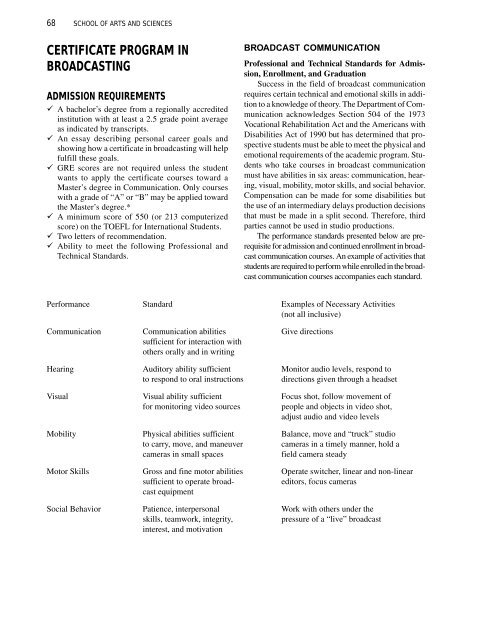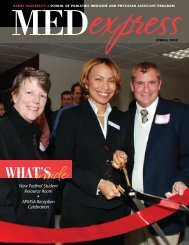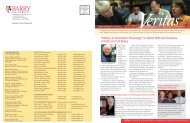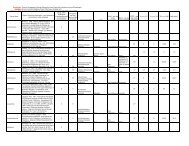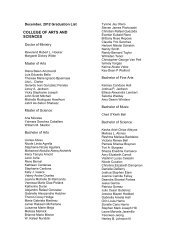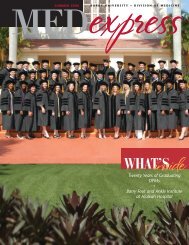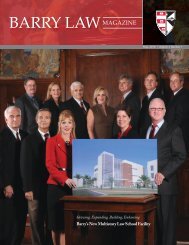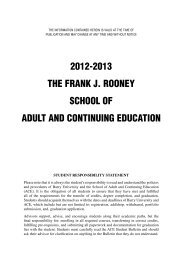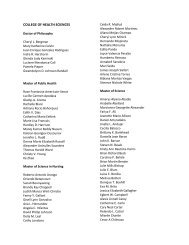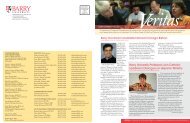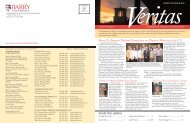2004-2005 - Barry University
2004-2005 - Barry University
2004-2005 - Barry University
Create successful ePaper yourself
Turn your PDF publications into a flip-book with our unique Google optimized e-Paper software.
68 SCHOOL OF ARTS AND SCIENCES<br />
CERTIFICATE PROGRAM IN<br />
BROADCASTING<br />
ADMISSION REQUIREMENTS<br />
� A bachelor’s degree from a regionally accredited<br />
institution with at least a 2.5 grade point average<br />
as indicated by transcripts.<br />
� An essay describing personal career goals and<br />
showing how a certificate in broadcasting will help<br />
fulfill these goals.<br />
� GRE scores are not required unless the student<br />
wants to apply the certificate courses toward a<br />
Master’s degree in Communication. Only courses<br />
with a grade of “A” or “B” may be applied toward<br />
the Master’s degree.*<br />
� A minimum score of 550 (or 213 computerized<br />
score) on the TOEFL for International Students.<br />
� Two letters of recommendation.<br />
� Ability to meet the following Professional and<br />
Technical Standards.<br />
BROADCAST COMMUNICATION<br />
Professional and Technical Standards for Admission,<br />
Enrollment, and Graduation<br />
Success in the field of broadcast communication<br />
requires certain technical and emotional skills in addition<br />
to a knowledge of theory. The Department of Communication<br />
acknowledges Section 504 of the 1973<br />
Vocational Rehabilitation Act and the Americans with<br />
Disabilities Act of 1990 but has determined that prospective<br />
students must be able to meet the physical and<br />
emotional requirements of the academic program. Students<br />
who take courses in broadcast communication<br />
must have abilities in six areas: communication, hearing,<br />
visual, mobility, motor skills, and social behavior.<br />
Compensation can be made for some disabilities but<br />
the use of an intermediary delays production decisions<br />
that must be made in a split second. Therefore, third<br />
parties cannot be used in studio productions.<br />
The performance standards presented below are prerequisite<br />
for admission and continued enrollment in broadcast<br />
communication courses. An example of activities that<br />
students are required to perform while enrolled in the broadcast<br />
communication courses accompanies each standard.<br />
Performance Standard Examples of Necessary Activities<br />
(not all inclusive)<br />
Communication Communication abilities Give directions<br />
sufficient for interaction with<br />
others orally and in writing<br />
Hearing Auditory ability sufficient Monitor audio levels, respond to<br />
to respond to oral instructions directions given through a headset<br />
Visual Visual ability sufficient Focus shot, follow movement of<br />
for monitoring video sources people and objects in video shot,<br />
adjust audio and video levels<br />
Mobility Physical abilities sufficient Balance, move and “truck” studio<br />
to carry, move, and maneuver cameras in a timely manner, hold a<br />
cameras in small spaces field camera steady<br />
Motor Skills Gross and fine motor abilities Operate switcher, linear and non-linear<br />
sufficient to operate broad- editors, focus cameras<br />
cast equipment<br />
Social Behavior Patience, interpersonal Work with others under the<br />
skills, teamwork, integrity, pressure of a “live” broadcast<br />
interest, and motivation


